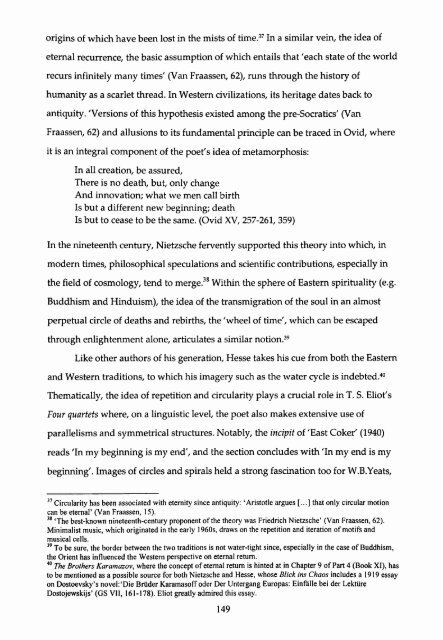HERMANN HESSE AND THE DIALECTICS OF TIME Salvatore C. P. ...
HERMANN HESSE AND THE DIALECTICS OF TIME Salvatore C. P. ...
HERMANN HESSE AND THE DIALECTICS OF TIME Salvatore C. P. ...
You also want an ePaper? Increase the reach of your titles
YUMPU automatically turns print PDFs into web optimized ePapers that Google loves.
origins of which have been lost in the mists of time. 37 In a similar vein, the idea of<br />
eternal recurrence, the basic assumption of which entails that 'each state of the world<br />
recurs infinitely many times 7 (Van Fraassen, 62), runs through the history of<br />
humanity as a scarlet thread. In Western civilizations, its heritage dates back to<br />
antiquity. 'Versions of this hypothesis existed among the pre-Socratics7 (Van<br />
Fraassen, 62) and allusions to its fundamental principle can be traced in Ovid, where<br />
it is an integral component of the poet's idea of metamorphosis:<br />
In all creation, be assured,<br />
There is no death, but, only change<br />
And innovation; what we men call birth<br />
Is but a different new beginning; death<br />
Is but to cease to be the same. (Ovid XV, 257-261, 359)<br />
In the nineteenth century, Nietzsche fervently supported this theory into which, in<br />
modern times, philosophical speculations and scientific contributions, especially in<br />
the field of cosmology, tend to merge.38 Within the sphere of Eastern spirituality (e.g.<br />
Buddhism and Hinduism), the idea of the transmigration of the soul in an almost<br />
perpetual circle of deaths and rebirths, the 'wheel of time7, which can be escaped<br />
through enlightenment alone, articulates a similar notion.39<br />
Like other authors of his generation, Hesse takes his cue from both the Eastern<br />
and Western traditions, to which his imagery such as the water cycle is indebted. 40<br />
Thematically, the idea of repetition and circularity plays a crucial role in T. S. Eliot's<br />
Four quartets where, on a linguistic level, the poet also makes extensive use of<br />
parallelisms and symmetrical structures. Notably, the incipit of 'East Coker7 (1940)<br />
reads 'In my beginning is my end', and the section concludes with 'In my end is my<br />
beginning7 . Images of circles and spirals held a strong fascination too for W.B.Yeats,<br />
37 Circularity has been associated with eternity since antiquity: 'Aristotle argues [...] that only circular motion<br />
can be eternal' (Van Fraassen, 15).<br />
38 'The best-known nineteenth-century proponent of the theory was Friedrich Nietzsche' (Van Fraassen, 62).<br />
Minimalist music, which originated in the early 1960s, draws on the repetition and iteration of motifs and<br />
musical cells.<br />
39 To be sure, the border between the two traditions is not water-tight since, especially in the case of Buddhism,<br />
the Orient has influenced the Western perspective on eternal return.<br />
40 The Brothers Karamazov, where the concept of eternal return is hinted at in Chapter 9 of Part 4 (Book XI), has<br />
to be mentioned as a possible source for both Nietzsche and Hesse, whose Blick ins Chaos includes a 1919 essay<br />
on Dostoevsky's novel:'Die Briider Karamasoff oder Der Untergang Europas: Einfa'lle bei der Lektiire<br />
Dostojewskijs' (GS VII, 161-178). Eliot greatly admired this essay.<br />
149
















